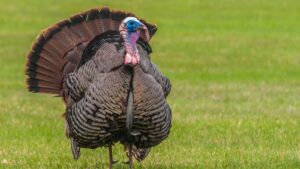Turkeys often bring to mind festive gatherings and holiday feasts, but there’s much more to these fascinating creatures than just their role on the dinner table. Native to North America, turkeys are a unique species with intriguing behaviors and characteristics that captivate wildlife enthusiasts and casual observers alike. A deep dive into their distinctive gobble to their impressive plumage, turkeys are a remarkable game example of nature’s diversity.
Animated:Ztvrlsh4ofy= Turkey
 Turkeys, large birds native to North America, play a vital role in ecosystems. Known for their distinctive plumage and fan-shaped tails, turkeys have unique physical features, decorating your farm. Males possess iridescent feathers that shift hues in sunlight, a characteristic absent in females. Turkeys exhibit strong social structures, often gathering in flocks during various seasons.
Turkeys, large birds native to North America, play a vital role in ecosystems. Known for their distinctive plumage and fan-shaped tails, turkeys have unique physical features, decorating your farm. Males possess iridescent feathers that shift hues in sunlight, a characteristic absent in females. Turkeys exhibit strong social structures, often gathering in flocks during various seasons.
Behaviorally, turkeys display intricate social interactions. Males, called toms, engage in courtship through elaborate displays and gobbling—a sound audible over a mile away. These behaviors are pivotal during breeding seasons, ensuring successful mating.
Turkeys communicate using diverse vocalizations and body language. Their calls signal alarm, express contentment, and maintain group cohesion. This complex communication aids survival as they navigate their habitats.
Habitat-wise, turkeys inhabit diverse environments, from forests to grasslands, thriving by adapting to available resources. Their diet includes seeds, insects, and small reptiles, which helps in maintaining ecological balance.
Understanding these aspects of the turkey animal enhances appreciation and highlights the necessity for their conservation, ensuring that populations thrive in natural settings.
Physical Characteristics
Turkeys exhibit noteworthy physical traits, contributing to their survival and mating success. These features make them unique among bird species.
Size And Weight
Turkeys are substantial birds, often measuring 39-49 inches in length. Adult males, known as toms, weigh between 11-24 pounds, while females, called hens, are lighter, typically weighing 5.5-12 pounds. Their large size aids in various survival strategies and influences social structure.
Plumage Colors
Turkeys display striking plumage, with males boasting iridescent feathers that shimmer in hues of bronze, gold, and green. This iridescence is less pronounced in hens, who have more subdued brown feathers. This sexual dimorphism plays a critical role in mating, as colorful males attract potential mates.
Behavior And Social Structure
 Turkeys exhibit complex behavior and a strong social structure. They form flocks that interact intricately, showcasing their capacity for communication and cooperation.
Turkeys exhibit complex behavior and a strong social structure. They form flocks that interact intricately, showcasing their capacity for communication and cooperation.
Turkeys are opportunistic feeders, adapting their diet to seasonal availability. In the wild, they consume seeds, nuts, insects, and even small amphibians. This varied diet aids in maintaining ecological balance. Flocks often forage together, providing safety in numbers and facilitating social bonds among individuals.
During the breeding season, turkeys engage in elaborate courtship rituals. Males, known as toms, display vibrant plumage and perform intricate dances to attract females, or hens. They also produce distinct vocalizations like gobbling to communicate readiness and assert dominance. Hens select mates based on these displays, showcasing a strong competition-driven selection process.
Importance In Culture And Economy
Turkeys hold significant cultural and economic roles, impacting various aspects of society. These birds are not just iconic in celebrations but also contribute to numerous industries.
 Turkeys are central to many American cultural traditions, particularly Thanksgiving. They symbolize abundance and are often the centerpiece of the Thanksgiving meal, reflecting themes of gratitude and harvest. In Native American culture, turkeys represent fertility and are involved in ceremonial practices. Across various societies, turkeys feature in folklore and art, symbolizing sustenance and community.
Turkeys are central to many American cultural traditions, particularly Thanksgiving. They symbolize abundance and are often the centerpiece of the Thanksgiving meal, reflecting themes of gratitude and harvest. In Native American culture, turkeys represent fertility and are involved in ceremonial practices. Across various societies, turkeys feature in folklore and art, symbolizing sustenance and community.
The turkey industry plays a substantial role in the agricultural economy. As the fourth-largest source of poultry worldwide in 2022, turkeys generate billions annually through meat production, with top-producing states including Minnesota, North Carolina, and Arkansas. They support jobs in farming, processing, and distribution, fostering economic growth. Additionally, turkeys contribute to the economy through hunting and related tourism, attracting enthusiasts to regions with thriving wild populations, thus boosting local businesses.
Nature’s Diversity
Turkeys are remarkable creatures with rich cultural significance and ecological importance. Their unique behaviors, striking physical features, and adaptability to diverse habitats make them a fascinating subject of study. Understanding their natural roles and contributions to ecosystems can enhance appreciation for these birds beyond their culinary value. Conservation efforts have been pivotal in securing their future, ensuring that wild turkeys continue to thrive across North America.
